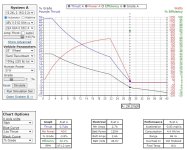Hello, I recently converted a fatbike to a fat-ebike. However, top speed isn't quite where I want it. My top speed is about 27mph on flat ground. I don't think there is a speed limiter, When I lift the motor wheel and hit the throttle, the speedometer shows about 34mph, so unless watts is being limited at higher speed, there isn't a speed limiter. It was a 1500w brushless motor kit with a 48v kt controller 22A continous, 45A Peak. Seems like my top speed should be higher with this setup but maybe not.
I was thinking about getting a 72v kt controller so that it's compatible with my lcd display and keep current the same at 45A by limiting max current through my display. The only problem is I already ordered two 48v 14ah 18650 battery packs from China a while ago and they should be arriving soon(I have been using 4 8ah lead acid batteries connected in series for the meantime). So, if I want to go to 72v, I would either need to disassemble the battery packs and reassemble them as 20s, or get two dc voltage boost converters rated for 1800w and connect them in parallel which is easier said than done due to having to implement load sharing, otherwise one would take all the load and burn up. Going the converter route would also be less efficient, take up more space, I wouldn't be able to monitor voltage on my display as voltage would be kept constant and brake regen won't work. I also plan on installing a temp. sensor in the motor.
Any ideas? Any feedback is appreciated.
Fyi, my end goal is around 40mph, this motor doesn't have to get me there alone as I plan on adding a 2nd motor in the future but it needs to have enough rpm to hit 40mph which it probably will after overvolting it.
I was thinking about getting a 72v kt controller so that it's compatible with my lcd display and keep current the same at 45A by limiting max current through my display. The only problem is I already ordered two 48v 14ah 18650 battery packs from China a while ago and they should be arriving soon(I have been using 4 8ah lead acid batteries connected in series for the meantime). So, if I want to go to 72v, I would either need to disassemble the battery packs and reassemble them as 20s, or get two dc voltage boost converters rated for 1800w and connect them in parallel which is easier said than done due to having to implement load sharing, otherwise one would take all the load and burn up. Going the converter route would also be less efficient, take up more space, I wouldn't be able to monitor voltage on my display as voltage would be kept constant and brake regen won't work. I also plan on installing a temp. sensor in the motor.
Any ideas? Any feedback is appreciated.
Fyi, my end goal is around 40mph, this motor doesn't have to get me there alone as I plan on adding a 2nd motor in the future but it needs to have enough rpm to hit 40mph which it probably will after overvolting it.



